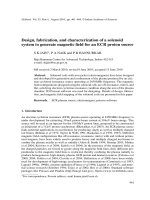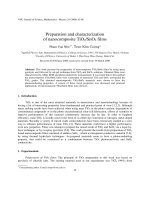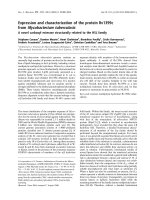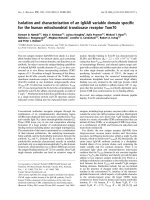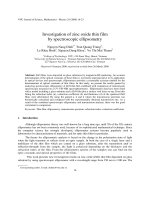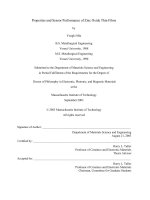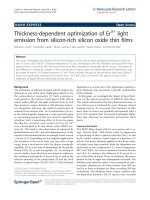Growth and characterization of nickel oxide thin films and nanostructures for novel device applications
Bạn đang xem bản rút gọn của tài liệu. Xem và tải ngay bản đầy đủ của tài liệu tại đây (4.72 MB, 155 trang )
GROWTH AND CHARACTERIZATION OF NICKEL OXIDE
THIN FILMS AND NANOSTRUCTURES FOR NOVEL
DEVICE APPLICATIONS
REN YI
(B. Eng, NUS)
A THESIS SUBMITTED
FOR THE DEGREE OF DOCTOR OF PHILOSOPHY
NUS Graduate School for Integrative Sciences and Engineering
NATIONAL UNIVERSITY OF SINGAPORE
2012
Declaration
I hereby declare that the thesis is my original work
and it has been written by me in its entirety. I have
duly acknowledged all the sources of information
which have been used in the thesis.
This thesis has also not been submitted for any
degree in any university previously.
________________
Ren Yi
26 November 2012
i
Abstract
In this dissertation, the growth and characterization of nickel oxide (NiO) for various
novel device applications are investigated. In the aspect of growth, many methods of both
solution-based and physical deposition were employed to optimize and improve both thin
film and nanostructure growth. Importantly, for the thin film growth, chemical bath
deposition (CBD) with various post-deposition annealing temperatures was used to grow
porous thin films with different composition and degree of crystallinity; while sputtering
with substrate heating was used to deposit thin films with excellent quality and
uniformity. For the nanostructure growth, the Kirkendall effect was examined in detail
and this was shown to be especially critical in growing NiO nanostructures. The
roughening effect on oxidation to form NiO nanowires was explained together, with the
interplay of vacancy diffusion rate and the dimensional sizes. In understanding the
limitations, the growth of NiO nanotubes with suitably uniform tube walls by oxidation
of nickel nanowires was demonstrated for the first time. The applications of NiO thin
films and nanostructures were then investigated for resistive switching memory and
electrochromic devices. For the NiO resistive switching memory, a filamentary switching
mechanism was demonstrated. It was found that the electrode material and the polarity of
the voltage bias played important roles in altering the filament formation process, thus
affecting the resistive switching behavior of the memory device. It was believed that an
electrochemically inert metal anode was essential for repeatable resistive switching of
NiO, because it limited the formation of a strong metal filament which could result in
permanent breakdown of the memory device. For applications in the electrochromic
ii
devices, the detailed coloration and degradation mechanisms of NiO were elucidated for
the first time. It was found that the initial hydration of the NiO films towards nickel
hydroxide proceeded gradually through a combination of coloration from hydroxyl ions
and bleaching through protons, and this process increased the optical modulation of the
deposited film. However, enhanced hydroxyl ion incorporation during coloration will
lead to water intercalation. Degradation occurs when the extensive intercalated networks
of water molecules isolated colored nickel oxy-hydroxide grains which resulted in
irreversible coloration of the device. It was also demonstrated that the degradation can be
easily reversed by thermal annealing.
iii
Acknowledgements
First and foremost, I would like to extend my sincere and greatest gratitude to my
supervisor A/Prof. Chim Wai Kin and co-supervisor Dr. Chiam Sing Yang for their
patient guidance and help throughout the candidature. Their advices and suggestions are
invaluable for me to overcome the problems I encountered, without which the completion
of this work would not be possible.
I would also like to express my appreciation to my Thesis Advisory Committee
consisting of A/Prof. Zhu Chunxiang and A/Prof. Lee Chengkuo Vincent for their time in
reviewing my work and giving valuable suggestions for improvement.
My heartfelt gratitude also goes to my senior PhD students Dr. Pi Can and Dr. Huang
Jinquan for their patient mentorship and guidance during my earlier candidature. I
treasure our friendships and all the time we spent together for both work and fun.
Special thanks go to Mrs. Ho Chiow Mooi and Mr. Koo Chee Keong for providing
training and assistance on the experimental equipment and logistics required in the Centre
for Integrated Circuit Failure Analysis and Reliability (CICFAR).
I also wish to thank the NUS Graduate School (NGS) for providing the scholarship and
various education and conference allowances during my candidature.
Last but not least, I wish to express my love and gratitude to my beloved parents and wife
for their endless love and understanding through my entire life.
iv
Table of Contents
Abstract i
Acknowledgements iii
Table of Contents iv
List of Figures viii
List of Tables xiv
Chapter 1 Introduction 1
1.1 Background and Motivation 1
1.2 Objectives 2
1.3 Organization of Thesis 3
Chapter 2 Literature Review 4
2.1 Growth of NiO Thin Film 4
2.1.1 Physical deposition of NiO thin film 4
2.1.2 Solution growth of NiO thin film 5
2.2 Growth of NiO Nanostructures by Thermal Oxidation 7
v
2.2.1 Fabrication of Ni nanowires 7
2.2.2 Oxidation of Ni nanowires by the Kirkendall effect 10
2.3 Application of NiO in Resistive Switching Memory 12
2.3.1 Resistive switching phenomena 14
2.3.2 Resistive switching materials and mechanism 16
2.3.2.1 Filament formation process 18
2.3.2.2 Filament rupture process 20
2.3.2.3 Electrode material dependency 21
2.4 Application of NiO in Electrochromic Smart Windows 23
2.4.1 Electrochromic materials and device structure 24
2.4.2 Electrochromic mechanism of NiO 26
Chapter 3 Experimental Details 29
3.1 Growth of Thin Films and Nanowires 29
3.1.1 Sputtering for thin film growth 29
3.1.2 Chemical bath deposition for porous film growth 30
3.1.3 Anodization, electrodeposition and oxidation for nanowire growth 31
3.2 Materials and Devices Characterization 33
3.2.1 Physical and chemical characterization 33
vi
3.2.2 Electrical characterization 35
3.2.3 Electrochemistry 36
3.3 Other Methodologies Involved 38
Chapter 4 NiO for Resistive Switching Memory 39
4.1 Thin Film Growth and Characterization 39
4.2 RS Device Characterization 41
4.3 Factors Affecting RS Behavior and the Filamentary Mechanism 44
4.3.1 Electrode size dependency 44
4.3.2 Compliance current dependency 45
4.4 Electrode Material and Bias Polarity Dependency Study 50
Chapter 5 NiO for Electrochromic Smart Window 59
5.1 Porous Thin Film Growth and Characterization 59
5.2 EC Device Characterization 64
5.3 EC Mechanism Study 68
5.3.1 Characterization results and discussion 68
5.3.2 Coloration and degradation mechanism 73
5.3.3 Regeneration from degradation 77
5.3.4 Summary 78
vii
Chapter 6 NiO for Nanostructured Device 80
6.1 Growth of NiO Nanostructures 81
6.1.1 Growth and characterization of the Ni nanowires 81
6.1.2 Oxidation of the Ni nanowire within the AAO template 84
6.1.3 Oxidation of dispersed Ni nanowires in the low temperature regime 86
6.1.4 Oxidation of dispersed Ni nanowire in the high temperature regime 92
6.1.5 Fabrication of uniform NiO nanotubes by chemical wet etching 99
6.1.6 Fabrication of uniform NiO nanotubes by varying nanowire diameter 101
6.1.7 Summary 111
6.2 Characterization of Nanostructured RS Device 112
6.3 Characterization of Nanostructured EC Device 117
Chapter 7 Conclusion 121
7.1 Summary of Findings and Conclusion 121
7.2 Recommendations for Future Work 124
References 127
Appendix A: List of Publications 139
viii
List of Figures
Figure 2-1 The ion diffusion process in the growth of hollow nanostructure by the
Kirkendall effect 10
Figure 2-2 (a) Typical current-voltage characteristics of (a) the unipolar resistive
switching and (b) the bipolar resistive switching. 15
Figure 2-3 Five-layer prototype for EC smart window devices. 25
Figure 3-1 Schematic diagram showing the setup for (a) the anodization of Al foil using a
voltage source and (b) the electrodeposition of Ni into AAO membrane using a
galvanostat. 32
Figure 4-1 XRD patterns of sputtered NiO films with (300 °C) and without (room
temperature) substrate heating. The various NiO peaks with different crystal orientation
are indicated. 40
Figure 4-2 Schematic diagram of the thin film RS device structure and the electrical
characterization setup through a probe station and parameter analyzer. 42
Figure 4-3 Current-voltage curves for a typical SET and RESET process with current in
(a) linear scale and (b) logarithmic scale. 43
Figure 4-4 (a) Plot of the average ON state resistance against electrode size. (b) Plot of
the average RESET voltage against electrode size. Results for each electrode size are
taken from 200 switching cycles as indicated by the error bars. 45
Figure 4-5 Plot of average ON state resistance against compliance current. Results for
each compliance current value are taken from numerous switching cycles (at least 100
switching cycles) as indicated by the error bars. 46
Figure 4-6 Current-voltage curves for an occasional switching cycle with step-like
characteristic, demonstrating the formation of multiple conductive filaments. 47
Figure 4-7 Plots of (a) average RESET current and (b) average RESET voltage against
the compliance current. Results for each compliance current value are taken from
numerous switching cycles (at least 100 switching cycles) as indicated by the error bars.
48
Figure 4-8 Plot of maximum number of switching cycles before dielectric breakdown
occurs (i.e. endurance) against the compliance current. 49
ix
Figure 4-9 Schematic diagram showing the formation process of the conductive filament
in NiO. (a) The drift of Ni ions to the cathode under the applied voltage bias. (b) Filament
growth by the reduction and accumulation of metallic Ni defects at the cathode. (c) The
stronger electric field at the top of the longer filament results in a faster growth rate of the
filament. (d) ON state of the MIM device is achieved by the formation of a conical
dendritic conductive filament between the cathode and the anode. 53
Figure 4-10 Random circuit breaker network simulation of a mesh of switching elements
after the electroforming process with a compliance current of 15 mA. The conductive
filament formed is represented in red color. The yellow horizontal bars at the top and
bottom represent the anode (+) and the cathode (-). 54
Figure 4-11 Plot of the OFF state resistance against the number of switching (endurance)
cycles for a Pt-NiO-Pt device switched with a compliance current of 10 mA. 55
Figure 4-12 Schematic diagram showing the formation of a strong metal filament with Al
as the anode. (a) The oxidation of the Al electrode and the drift of Al ions under bias. (b)
The formation of a metal filament from the reduction of both Ni and Al ions. 56
Figure 5-1 The SEM image of as-deposited CBD Ni(OH)
2
film without post-deposition
anneal. 60
Figure 5-2 (a) SEM image of the as-deposited CBD Ni(OH)
2
film with ultrasonic clean
for 1 minute. (b) SEM image of the same sample under higher magnification showing the
porous structure of the CBD film. 61
Figure 5-3 (a) FTIR reflectance spectra of the as-deposited CBD film after post-
deposition annealing at 300 °C, 400 °C and 500 °C for 90 minutes. Inset shows the
transmittance of the respective films at a wavelength of 550 nm. (b) XRD pattern of the
CBD film after 500 °C post-deposition anneal. Labeled peaks showing the different
crystal orientation are from the NiO film while the other peaks that are not labeled or
identified are from the ITO-on-glass substrate. 63
Figure 5-4 Cyclic voltammetry current-voltage curves for (a) the CBD film with 300 °C
anneal and (b) the CBD film with 500 °C anneal at the indicated potential cycle. Arrows
show the shift of the reduction and oxidation (redox) current peaks. 65
Figure 5-5 (a) Photograph of the bleached and colored 300 °C annealed NiO thin film
after 90 potential cycles demonstrating excellent optical modulation. (b) Plot of the UV-
Vis transmittance at 550 nm wavelength against the number of potential cycles for the
colored and bleached CBD films after post-deposition anneal at 300 °C, 400 °C and
500 °C. The optical modulation is shown as a dash line. 66
Figure 5-6 (a) FTIR reflectance spectra of Ni-related vibrational peaks for the bleached
(B) and colored (C) states of the CBD film after 300 °C anneal at the indicated potential
x
cycle. The respective transmittance of each state is shown as the accompanying inset. (b)
The FTIR reflectance spectra of OH-related vibration modes of 300 °C annealed films at
the bleached state after the indicated potential cycles. 69
Figure 5-7 FTIR reflectance spectra of (a) the CBD NiO film after 500 °C anneal and (b)
the as-deposited CBD film at the indicated potential cycles. 72
Figure 5-8 (a) A summary of reactions during potential cycling between bleached and
colored states of NiO. Two pairs of intertwined redox reactions gradually converts NiO
into Ni(OH)
2
(evolution) and finally hydrates it to NiOOH (hydration) where continuous
hydration causes isolation. (b) Schematics demonstrating evolution of NiO into Ni(OH)
2
.
(I) The initial NiO grains with surface Ni(OH)
2
. (II) Outward diffusion of H
+
ions colors
Ni(OH)
2
. Inward diffusion of OH
-
ions colors deeper NiO. (III) Subsequent bleaching
process with H
+
ions converts NiOOH to Ni(OH)
2
as the NiO/Ni(OH)
2
interface moves
inwards. (IV) This evolution then repeats itself to continuously activate NiO. 74
Figure 5-9 Schematics demonstrating isolation process. Solid lines represent intercalated
water. Coloration (I) and bleaching (II) can proceed if there is no isolation. During
coloration, when intercalated water is introduced, regions of NiOOH can be surrounded
by these water molecules (III). The isolated NiOOH then becomes inactive and remains
colored even during the bleaching cycle (IV). Coloration (V) and bleaching (VI) then
proceed with an increasing amount of NiOOH isolation. 75
Figure 5-10 FTIR reflectance spectra of the bleached and colored 300 °C annealed CBD
films after 350 potential cycles (isolation state, low optical modulation) and the same
sample after a post-cycling anneal at 300 °C (regenerated, high optical modulation). 77
Figure 6-1 SEM image of the surface of the fabricated through-pore AAO template. 81
Figure 6-2 (a) SEM image of the cross section of the AAO template after the
electrodeposition of Ni into the AAO pores. (b) SEM image of the top surface of the
AAO template after the electrodeposition showing no overflow of Ni. 82
Figure 6-3 (a) SEM image of Ni nanowires after the removal of AAO through chemical
etching by NaOH solution. (b) TEM image of a single Ni nanowire after dispersion from
the as-grown sample. (c) HRTEM image of a single Ni nanowire. The areas indicated by
“A”, “B” and “C” represent three regions with different grain orientations as verified
using fast Fourier transform analysis. (d) XRD pattern of dispersed clusters of Ni
nanowires showing the metallic Ni (111), (220) and (200) peaks. Additional peaks are
identified as hydroxides. 83
Figure 6-4 SEM images showing (a) the exposed top of the standalone Ni nanowires after
partial etching of the AAO template and (b) after the oxidation at 450 °C for 6 hours.
SEM images showing oxidized Ni nanowire (c) at the edge and (d) within the crack of the
AAO template. 85
xi
Figure 6-5 TEM images of Ni nanowires after 450 °C furnace annealing for 10 hours
showing the (a) Global view of a typical wire, (c) Magnified image of a nanowire
showing small and large void formation starting at the interface of the sheath and the
solid Ni wire, and (d) Magnified image of a void free of any Ni metal contribution (local
NiO tube). (b) EDX line profiles of the tube-wire heterojunction (shown in the inset)
using STEM showing the relative counts for Ni and O. 88
Figure 6-6 (a) XRD spectrum of dispersed cluster of Ni nanowires after 450 °C furnace
annealing for 10 hours. (b) Schematic showing two different cases for vacancy diffusion
and agglomeration during metal oxidation. Path A: Higher rate of vacancy generation at
the interface as compared to the vacancy diffusion resulting in the formation of multiple
small voids along the interface. Path B: Rapid diffusion of vacancies resulting in the
formation of big voids which minimize the surface free energy. 89
Figure 6-7 (a) TEM image of Ni nanowire after 550 °C RTO for 5 minutes. (b) TEM
image of Ni nanowire after 650 °C RTO for 5 minutes. (c) SEM image of Ni nanowire
after 650 °C RTO for 5 minutes. The circled areas show the break points of NiO
nanotubes revealing the hollow openings. (d) XRD spectrum of clusters of Ni nanowires
after 650 °C RTO for 5 minutes. 93
Figure 6-8 (a) A representation of different Ni nanowires obtained after oxidation at each
important temperature regimes. TEM images (from top) are Ni nanowire after 5 minutes
RTO at 650 °C, 550 °C, 450 °C and 350 °C respectively. (b) TEM image of Ni nanowire
after 650 °C spike annealing. (c) Schematics and TEM micrographs illustrating the step-
wise manner of Ni nanowire evolution during the ramp up stage in a typical 5 minutes
RTO process at 650 °C. The left most TEM micrograph is the initial Ni wire before
oxidation. The TEM micrograph in step 4 is the resultant bamboo like structure after the
5 minutes RTO process. The Ni nanowire structures during the ramp up stage are
represented by spike anneals to a maximum temperature of 450 °C, 550 °C and 650 °C.
The spike anneal temperature profile is indicated by the dotted line. 97
Figure 6-9 (a) TEM image of a NiO nanotube achieved by removal of the Ni residual
core from a 450 °C RTO Ni nanowire. The image shows a relatively uniform NiO
nanotube. The inset is a high resolution TEM image of the nanotube. (b) XRD pattern of
the annealed and etched NiO nanotubes showing the absence of metallic Ni and the
presence of the NiO diffraction peaks. 100
Figure 6-10 (a) Histogram of number of incidences versus the vacancy diffusion length
for Ni nanowires during the initial ramp up stage of the oxidation process. The vacancy
diffusion length is estimated as half of the distance between the centers of two adjacent
voids. (b) Histogram of the number of incidences versus the diameter of thick nanowires
before and after 650 °C RTO for 5 minutes. 102
Figure 6-11 (a) TEM image of a thick Ni nanowire (250 nm diameter) after 450 °C RTO
for 5 minutes. The inset is a TEM image of a thin Ni nanowire (80 nm diameter) after
xii
450 °C RTO for 5 minutes. (b) XRD spectrum of a dispersed cluster of Ni nanowires
after 450 °C RTO for 5 minutes. 103
Figure 6-12 Schematic showing two different types of voids formed during oxidation of
nanowires of the same material but with different diameters. Path A: Smaller diameter in
comparison with the diffusion length allows for wall-to-wall diffusion. This results in the
formation of big voids which minimize the surface free energy. The heterojunction-like
structure serves as a precursory template for the formation of bamboo-like structures at
high temperature, as shown in the final structure obtained. Path B: Larger nanowire
diameter, that is at least comparable to the vacancy diffusion length, means that vacancies
tend to diffuse and agglomerate along the interface. This results in the formation of
multiple voids along the interface which facilitates the development of a uniform tube
wall at high temperature as shown in the final structure obtained. 104
Figure 6-13 (a) TEM images of thick Ni nanowires (250 nm diameter) after 500 °C RTO
for 5 minutes. (b) EDX line profile of a 250 nm Ni nanowire after 500 °C RTO for
5 minutes using STEM. The profiled image is shown in the inset while the plot shows the
oxygen and nickel concentration as represented by the X-ray counts. 107
Figure 6-14 TEM images of Ni nanowires with intermediate diameters of 140 nm and
200 nm after 500 °C RTO for 5 minutes. The nanowire in the top figure is oxidized from
a Ni nanowire with diameter of 140 nm while the nanowire in the bottom figure is
oxidized from a Ni nanowire with diameter of 200 nm. 108
Figure 6-15 (a) TEM image of thick Ni nanowire (250 nm diameter) after 650 °C RTO
for 5 minutes. The inset is the XRD spectrum of the nanotubes formed under the same
condition showing the absence of metallic Ni and the presence of the NiO diffraction
peaks. (b) SEM image of thick Ni nanowire (250 nm diameter) after 650 °C RTO for 5
minutes. The hollow tube openings can be seen in the SEM image. 109
Figure 6-16 SEM image of the patterned electrodes fabricated by photolithography for
the RS characterization of NiO nanostructures 113
Figure 6-17 SEM image of a RS memory device fabricated by depositing metal
electrodes on dispersed Ni nanowire followed by oxidation. 114
Figure 6-18 SEM images of the degraded metal electrode due electromigration under
high voltage stress (a) near the nanowire device and (b) near the edges of the patterned
electrode. 115
Figure 6-19 (a) SEM image of dispersed Ni nanowires on ITO-on-glass substrate. (b) CV
current-voltage curves of dispersed NiO nanowire device for 25 cycles. 118
xiii
Figure 6-20 (a) CV current-voltage curves for dispersed NiO nanowire device and CBD
NiO thin film device. (b) Simplified schematic diagram of dispersed nanowires on
substrate showing the actual contact area for electrochemical reaction. 119
xiv
List of Tables
Table 2-1 Summary of performance parameters for current Flash memory and RRAM as
well as the requirements for emerging RRAM based on ITRS 2011. 12
Table 4-1 Summary of the RS behavior in NiO memory devices with different
combination of Pt and Al metal electrodes. 51
1
Chapter 1 Introduction
1.1 Background and Motivation
Nickel Oxide (NiO), a semiconducting metal oxide, is an important material for use in
device applications such as gas sensors, dye sensitized photocathodes and electrodes in
alkaline batteries. In addition, two exciting novel applications based on NiO have been
developed recently. One is an electronic application as a resistive switching (RS) memory
and the other is an energy-saving application as an electrochromic (EC) smart window.
The RS phenomenon in binary transition metal oxides has received considerable attention
because of the potential application in non-volatile memory devices that combine rapid
read and write speeds, high storage density and non-volatility [1]. NiO is a promising
material in this area due to its high ON/OFF resistance ratio and CMOS compatibility.
The EC property of the NiO is also important for enabling technologies such as smart
windows and non-volatile displays. The stability of the open-circuit memory effect can
translate to possible energy savings in integrated windows application for enabling indoor
comfort [2]. NiO is often preferred because it is the only low cost and highly efficient
anodic EC material [3]. However, the exact mechanisms behind both the RS and EC
phenomena have not been fully understood and the device performance still need to be
further improved.
Although thin film devices can be easily fabricated and demonstrate stable functionality
in both RS and EC devices, the merits of using nanostructured devices should not be
overlooked. For the RS memory application, nanostructures have the potential of
2
achieving extremely high-density addressable architectures. With respect to the
filamentary switching mechanism, the use of nanostructures may also improve the device
switching speed and stability and result in less energy consumption by constraining the
conductive filament formation. An enhancement of the RS properties in nanowire based
resistive memory device has already been demonstrated by a collaborated work using
other material than NiO [4]. For the application in EC smart windows, the large surface
area to volume ratio of nanostructures allows fast and efficient diffusion of ions which
may enhance the efficiency of EC reactions. The enhanced reaction rate can largely
reduce the response time and support a thicker EC active layer which may also improve
the optical modulation of the smart window.
1.2 Objectives
In this work, the aim is to fabricate RS and EC devices based on NiO thin film grown by
various growth methods. The deposition conditions, such as annealing temperature, will
be varied in order to modify the properties of the deposited film, including composition
and crystallinity. Sputtered NiO film is mainly used for RS application due to its uniform
coverage and controllable thickness, while the chemical bath deposited film is mainly
used for EC application due to its porous structure with large surface area to volume ratio
for efficient EC reactions. Through the characterization of the functional device
structures, we aim to identify the fundamental RS and EC mechanisms and then attempt
to optimize the device performance by modifying the film properties and device
structures.
3
In the next stage, we attempt to grow and characterize NiO nanostructures through the
oxidation of nickel (Ni) nanowires. Ni nanowires are fabricated using a template-assisted
method by electrodepositing Ni into an anodic aluminum oxide (AAO) template. The
fabrication process has the potential of fabricating a self-assembled nanostructure device.
With the understanding and experiences obtained from the fabrication and
characterization of the thin film based devices, we attempt to fabricate RS and EC
devices using NiO nanostructures with the hope of improving the RS and EC
performance with their unique structural properties.
1.3 Organization of Thesis
The contents of this thesis are organized into seven chapters describing the studies on
fabrication and characterization of NiO based RS and EC devices. Following the present
introductory chapter (Chapter 1), Chapter 2 gives a detailed literature review on the
current development of the RS and EC applications of NiO including both the fabrication
processes as well as the device performance. The experimental details for the setups and
processes used in this work are described in Chapter 3. There are three chapters that
discuss the experimental findings. Chapters 4 and 5 present the results and discussion on
the fabrication, characterization and optimization of the RS and EC thin film based
devices respectively. Chapter 6 extends the investigation to nanostructure based device
by giving a detailed description of the NiO nanostructure growth, device fabrication as
well as the performance of the nanostructured devices in the above areas of interest.
Lastly, Chapter 7 summarizes the accomplishments of this work and the thesis is
concluded by suggesting a number of recommendations for future work.
4
Chapter 2 Literature Review
2.1 Growth of NiO Thin Film
2.1.1 Physical deposition of NiO thin film
Physical deposition of the NiO thin film can be achieved by sputtering [3], pulsed laser
deposition [5], evaporation [6], atomic layer deposition [7] and oxidation of metallic Ni
[8]. In this work, the sputtering method is preferred because of its low deposition cost,
low fabrication temperature and industrial availability. The film deposited by sputtering
also has a conformal coverage and a better adhesion to the substrate. Sputter deposition is
a physical vapor deposition method in which materials from a target, which are ejected
by the bombardment of energetic particles, are deposited on the sample substrate. For
insulating targets such as NiO, positive charge will build up on the negatively biased
target due to bombardment by energetic positive ions. This means that extremely high
voltage is required to sputter off materials from the insulating target. To avoid charge
build up, radio frequency (RF) sputtering, which utilizes an alternating potential instead
of a direct current (DC) potential, is used. The film deposited at room temperature shows
an almost amorphous phase with defects due to the insufficient diffusion and
redistribution of adatoms. The quality and crystallinity of the deposited NiO film can be
improved with increasing growth temperature [9].
The sputter gas is usually an inert gas, typically argon. In certain cases, reactive
sputtering can be used in which a reactive gas such as oxygen is introduced to deposit the
oxide film by chemical reaction with the metallic target. The composition of the film can
5
be controlled by changing the relative pressures of the inert and reactive gases. DC and
RF reactive sputtering from a metallic Ni target can produce films with good
electrochromic and resistive switching properties [3, 10]. However, magnetism of the Ni
target poses technical problems and it is more advantageous to deposit NiO films from
non-magnetic targets. In this work, we will use the RF sputtering technique with a NiO
target instead of reactive sputtering with a Ni target. Different substrate heating
temperatures are used to modify the film structure for optimizing the device performance.
Additionally, NiO thin films fabricated by thermal oxidation of evaporated Ni film are
also characterized for comparison with the sputtered films.
2.1.2 Solution growth of NiO thin film
Solution-based NiO thin film growth methods include electrodeposition [11], sol-gel
process [12] and chemical bath deposition (CBD) [13]. The CBD method is preferred due
to its low cost, low fabrication temperature and also the convenience for large-scale
deposition (i.e. scalability). The porous nature of the CBD thin film is particularly
suitable for EC application due to the enhanced electrochemical reaction rate for a porous
film. The CBD method for NiO deposition, using nickel sulfate, potassium persulfate and
aqueous ammonia, was proposed by Pramanik and Bhattacharya [14]. The as-deposited
film appears brown in color and becomes transparent after annealing. It is believed that,
in addition to nickel hydroxide (Ni(OH)
2
), a small amount of nickel oxy-hydroxide
(NiOOH) is produced, which is then decomposed by annealing. This is confirmed by the
6
X-ray diffraction (XRD) characterization which shows the existence of NiOOH in the as-
deposited films, but not in the annealed samples, and the annealed films contain only
polycrystalline NiO [13]. However, the exact mechanism of oxide formation using
persulfate is unclear. It has been shown that neither the replacement of aqueous ammonia
with potassium hydroxide or sodium hydroxide nor the absence of potassium persulfate
will produce a Ni(OH)
2
film on the substrate [14, 15]. One possible mechanism, indicated
by reactions (2.1.1) and (2.1.2), is the homogeneous nucleation and precipitation of
Ni(OH)
2
nanoparticles followed by a molecular level heterogeneous oxidation reaction
with the persulfate [15].
Ni
2+
+ 2OH
-
→ Ni(OH)
2
(2.1.1)
2Ni(OH)
2
+ S
2
O
8
2-
→ 2NiOOH + 2SO
4
2-
+ 2H
+
(2.1.2)
After an initial linear growth regime lasting about a few minutes, a depletion regime is
encountered in which the growth rate drops rapidly to near zero and the final thickness of
the film is attained. As the stirring rate of the deposition solution increases, the duration
of the linear growth regime is shortened and the final film thickness is reduced. This can
be understood by the decrease in the entrapment of the nanoparticles as the stirring rate
increases. The study of the effect of annealing on as-deposited films by thermogravimetry
shows a dehydration process of the adsorbed water at 200 °C and a decomposition
process to NiO at around 300 °C [13, 15]. Higher annealing temperature leads to greater
dehydration and the heating process removes most of the water and intercalated species.
7
2.2 Growth of NiO Nanostructures by Thermal Oxidation
2.2.1 Fabrication of Ni nanowires
Nanowire structures can be fabricated by chemical vapor deposition [16, 17], template-
assisted sol-gel [18] and electrochemical [19, 20] synthesis, and many other methods.
Among these methods, electrodeposition of metal into an anodic aluminum oxide (AAO)
template offers good uniformity and easy control over the diameter and length of the
nanowires deposited, which follow exactly the shape of the pores of the template. The
AAO template is a porous membrane with a regular columnar pore structure which is
vertical to the substrate surface and parallel to each other. The diameter and length of the
pores can be separately tuned to achieve an aspect ratio (ratio of pore depth to pore
diameter) of between 10 and 1000. The pore diameter mainly depends on the composition
of the electrolyte and anodization voltage; while the pore depth is controlled by the
anodization duration.
The AAO templates are fabricated via the simultaneous oxidation of an aluminum (Al)
anode and the dissolution of the aluminum oxide (Al
2
O
3
) formed in an acidic electrolyte
[21]. During the anodization process, a constant voltage is applied between an Al foil
anode and an inert cathode. The electric field drives negatively charged hydroxyl ions
(OH
-
) to the anode which generates oxygen ions (O
2-
) according to reaction (2.2.1).
4OH
-
→ 2H
2
O + 2O
2-
(2.2.1)
8
The oxygen ions subsequently react with aluminum to form a layer of Al
2
O
3
as shown in
reaction (2.2.2).
2Al
3+
+ 3O
2-
→ Al
2
O
3
(2.2.2)
While Al
2
O
3
continuously grows at the oxide-metal interface through the reaction among
OH
-
, O
2-
and Al
3+
, the dissolution of the oxide at the electrolyte-oxide interface results in
thinning of the oxide layer.
In an acidic electrolyte, when the rate of oxidation is equal to that of dissolution, the
anodization process continues without a net change in the thickness of the oxide layer.
Defects such as impurities, dislocations as well as the rough surface of the Al foil will
alter the electric field leading to the growth of pits. Although a pit can grow in both
vertical and horizontal directions resulting in a pore with continuously increasing
diameter and length, the horizontal growth will be confined when the wall of two
adjacent pores are merged. The lack of Al source as well as the horizontal repulsive
electric field will prevent further widening of the pores. When the self-adjustment of the
inter-pore distance takes place across the entire anodized area, a hexagonal pattern can be
achieved. It has been reported that the inter-pore distance increases with the anodization
voltage. In addition, the use of sulfuric acid, oxalic acid and phosphoric acid as the
anodization electrolyte will produce AAO membrane with increasing pore diameters (in
the order shown for the acidic electrolyte) [22].
Since the pores are originated from the defects located randomly on the Al surface, the
formation of regular pores takes a long time and one is typically left with a layer of
9
irregular porous structure at the top of the AAO membrane for a single-step anodization
process. A two-step anodization process [23] can ensure a more regular pore formation at
the beginning of the anodization and throughout the growth of the membrane. This is
because when the alumina layer is removed after the first anodization, an ordered
concave structure of dimples is left on the Al surface. This artificially created regular
structure serves as the nucleation sites for pore growth during the second anodization step.
As a result a membrane with much regular pore arrangement will be formed in the second
anodization.
After the fabrication of the AAO membrane, the barrier layer can be removed by a pore
widening process to obtain a through-pore template for direct current (DC)
electrodeposition process. A metal layer (e.g. gold), served as a working electrode for the
subsequent metal electrodeposition, is then deposited on the back of the AAO membrane.
The electrodeposition of Ni can be carried out in a Ni salt solution. Ni(OH)
2
precipitates
on the electrode surface at higher potentials because of the high interfacial pH caused by
hydrogen evolution. The addition of boric acid to the electrolyte solution can prevent the
passivation of the electrode by Ni(OH)
2
, thereby enabling the continuous reduction of Ni
at the working electrode [24]. It has been reported that the crystallinity of the deposited
Ni nanowires increases with increasing deposition current density [20].
The AAO template can be easily removed by dissolving in sodium hydroxide solution
leaving only Ni nanowires standing on the substrate for further dispersion and oxidation.
The fabrication of the AAO template on a transparent conductive substrate, such as ITO-
